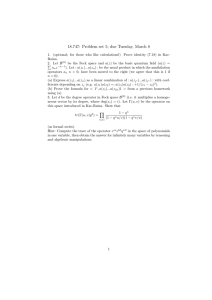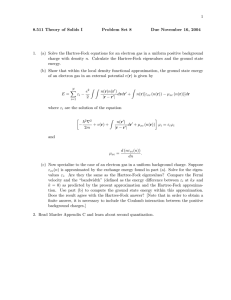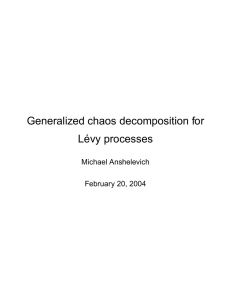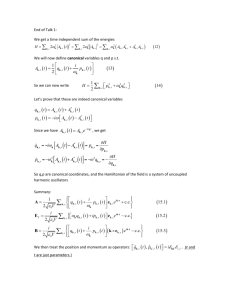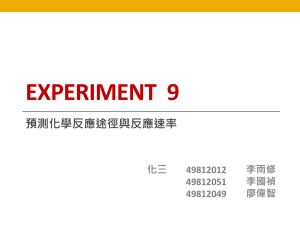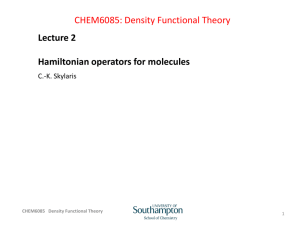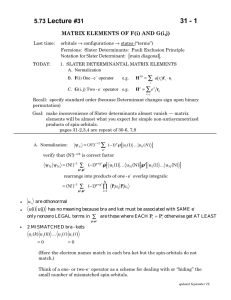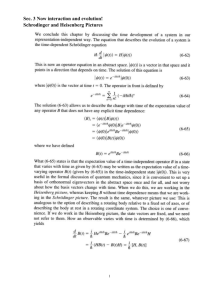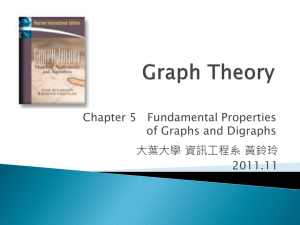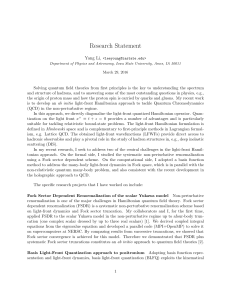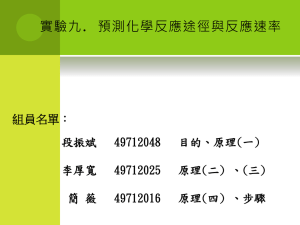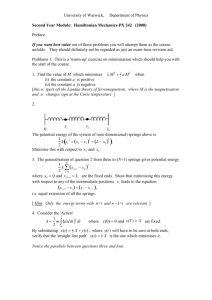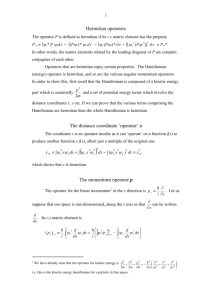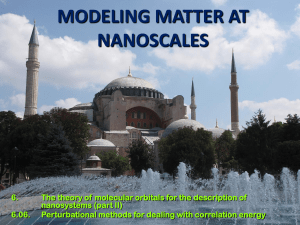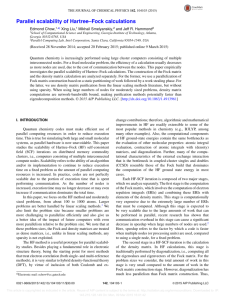Presentation Slides
advertisement
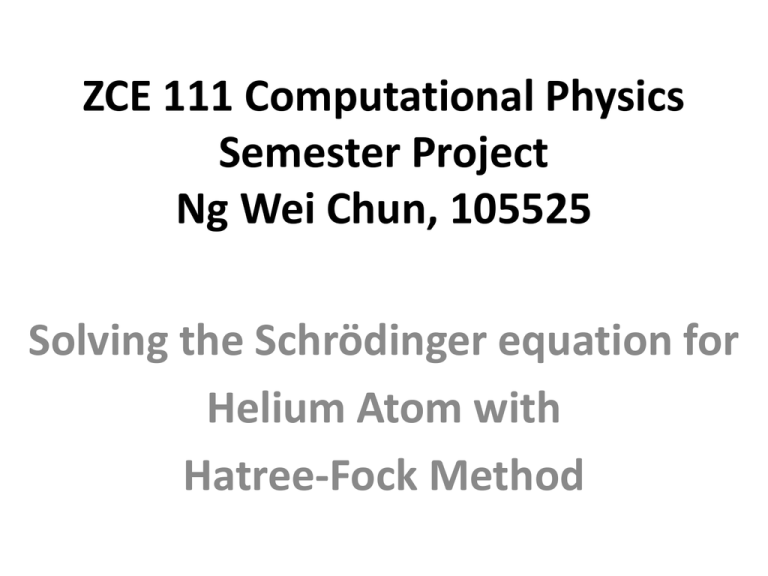
ZCE 111 Computational Physics Semester Project Ng Wei Chun, 105525 Solving the Schrödinger equation for Helium Atom with Hatree-Fock Method Helium Ground State with Gaussian s-basis Function Hamiltonian of a system of N electrons, K nuclei, with Zn charges • 𝐻= 1 1 4𝜋𝜀0 2 1 1 4𝜋𝜀0 2 𝑝𝑖2 𝑁 𝑖=1 2𝑚 + 𝑃𝑛2 𝐾 𝑛=1 2𝑀 𝑛 + 𝑒2 1 𝑁 𝑖,𝑗=1;𝑖≠𝑗 𝑟 −𝑟 − 4𝜋𝜀 0 𝑖 𝑗 2 𝑍 𝑍 𝑒 ′ 𝑛 𝑁 𝑛 𝑖,𝑗=1;𝑖≠𝑗 𝑅 −𝑅 ′ 𝑛 𝐾 𝑛=1 𝑍𝑛 𝑒 2 𝑁 𝑖=1 𝑟 −𝑅 𝑛 𝑖 + 𝑛 (4.1) • Index i for electrons, n for nuclei, m = electron mass, Mn = nuclei masses. Born-Oppenheimer approximation • Nuclei are much heavier that they move much slower than electron. • 𝐻𝐵𝑂 = − 1 4𝜋𝜀0 𝑝𝑖2 1 1 𝑁 𝑖=1 2𝑚 + 4𝜋𝜀 2 0 2 𝑍 𝑒 𝑛 𝑁 𝐾 𝑛=1 𝑖=1 𝑟 −𝑅 𝑛 𝑖 2 𝑒 𝑁 𝑖,𝑗=1;𝑖≠𝑗 𝑟 −𝑟 𝑖 𝑗 (4.2) The independent-particle (IP) Hamiltonian • Further approximation reduce the 2nd term of (4.2) to an uncoupled Hamiltonian. • 𝐻𝐼𝑃 = 𝑝𝑖2 𝑁 𝑖=1 2𝑚 + 𝑉 𝑟𝑖 (4.3) Anti-symmetric trial wave function for ground state • Ψ 𝑥1 , 𝑥2 = Ψ 𝑟1 , 𝑠1 ; 𝑟2 , 𝑠2 = 1 𝜙(𝑟1 )𝜙(𝑟2 ) 𝛼 𝑠1 𝛽 𝑠2 − 𝛼(𝑠2 )𝛽(𝑠1 ) 2 (4.4) • 𝛼 𝑠 = spin up, 𝛽 𝑠 = spin down, 𝜙 is an orbital which share the same basis. • The coordinates of the wave function are 𝑥1 and 𝑥2 , 𝑥𝑖 = 𝑟𝑖 , 𝑠𝑖 . Born-Oppenheimer Hamiltonian for the helium atom • 𝐻𝐵𝑂 = 1 − 𝛻1 2 2 1 + 𝛻2 2 2 + 1 𝑟1 −𝑟2 − 2 𝑟1 − 2 𝑟2 (4.5) • Acting on (4.4), • 1 2 − 𝛻1 2 + 1 2 𝛻2 2 − 2 𝑟1 − 2 𝑟2 + • multiply both side by 𝜙 ∗ (𝑟1 ) and integrate over 𝑟2 : • 1 2 − 𝛻1 2 − 2 𝑟1 3 + 𝑑 𝑟2 𝜙 𝑟2 = 𝐸 ′ 𝜙(𝑟1 ) 2 1 𝑟1 −𝑟2 𝜙 𝑟1 (4.7) • All the integrals which yield constant multiple of 𝜙 𝑟1 are absorbed into 𝐸 ′ . • Hereby, we have used 𝜙 ∗ 𝑟𝑖 𝜙 𝑟𝑗 = 𝛿𝑖𝑗 . • Equation (4.7) is self-consistent. Basis functions • Beyond restricting the wave function to be uncorrelated; by writing it as a linear combination of 4 fixed, real basis functions. • 𝜙 𝑟 = 4 𝑝=1 𝐶𝑝 𝜒𝑝 𝑟 (4.12) • Leads directly from (4.7) that: • 1 2 − 𝛻1 2 − 2 𝑟1 + • Multiply 𝜒𝑝 𝑟1 from the left and integrate over 𝑟1 : • 𝑝𝑞 ′ 𝐶 𝐶 𝑄 𝐶 = 𝐸 𝑟𝑠 𝑟 𝑠 𝑝𝑟𝑞𝑠 𝑞 ℎ𝑝𝑞 + 𝑝𝑞 𝑆𝑝𝑞 𝐶𝑞 (4.14) • ℎ𝑝𝑞 = 1 2 𝜒𝑝 − 𝛻 2 • 𝑄𝑝𝑟𝑞𝑠 = 3 2 − 𝑟 𝜒𝑞 3 𝑑 𝑟1 𝑑 𝑟2 𝜒𝑝 𝑟1 𝜒𝑟 𝑟2 1 𝑟1 −𝑟2 𝜒𝑞 𝑟1 𝜒𝑠 𝑟2 • 𝑆𝑝𝑞 = 𝜒𝑝 𝜒𝑞 , overlap matrix (4.15) Gaussian s−basis function • 𝜒𝑝 𝑟 = 𝑒 −𝛼𝑝 𝑟 2 (4.16) • 𝑄𝑝𝑟𝑞𝑠 = 2𝜋5 2 𝛼𝑝 +𝛼𝑞 𝛼𝑟 +𝛼𝑠 𝛼𝑝 +𝛼𝑞 +𝛼𝑟 +𝛼𝑠 (4.17) • 𝛼1 = 0.298073 ,𝛼2 = 1.242567 , 𝛼3 = 5.782948, and 𝛼4 = 38.474970 Program flow • The 4 × 4 matrices ℎ𝑝𝑞 , 𝑆𝑝𝑞 and 4 × 4 × 4 × 4 array 𝑄𝑝𝑟𝑞𝑠 are calculated. • Initial values for 𝐶𝑝 are chosen. • Use C-values to construct matrix F: • 𝐹𝑝𝑞 = ℎ𝑝𝑞 + 𝑟𝑠 𝑄𝑝𝑟𝑞𝑠 𝐶𝑟 𝐶𝑠 (4.18) • Always check that 4𝑝,𝑞=1 𝐶𝑝 𝑆𝑝𝑞 𝐶𝑞 = 1, as the normalisation. (4.19) • Solve for generalised eigenvalue problem • 𝑭𝑪 = 𝐸 ′ 𝑺𝑪 • • • • (4.20) For ground state, the vector C is the one corresponding to the lowest eigenvalue. Solution C from (4.20) is used to build matrix F again and so on. Ground state energy can be found by evaluating the expectation value of the Hamiltonian for the ground state: 𝐸𝐺 = 2 𝑝𝑞 𝐶𝑝 𝐶𝑞 ℎ𝑝𝑞 + 𝑝𝑞𝑟𝑠 𝑄𝑝𝑟𝑞𝑠 𝐶𝑝 𝐶𝑞 𝐶𝑟 𝐶𝑠 (4.21) General Hartree-Fock Method Particle-exchange operator, 𝑷𝑖𝑗 • 𝑷𝑖𝑗 Ψ 𝑥1 , 𝑥2 , … , 𝑥𝑖 , … 𝑥𝑗 , … , 𝑥𝑁 = Ψ 𝑥1 , 𝑥2 , … , 𝑥𝑗 , … 𝑥𝑖 , … , 𝑥𝑁 (4.22) • For the case of an independent-particle Hamiltonian, we can write the solution of the Schrödinger equation as a product of oneelectron states: • Ψ 𝑥1 , … , 𝑥𝑁 = 𝜓1 𝑥1 … 𝜓𝑁 𝑥𝑁 (4.24) Spin-orbitals permuted • The same state as (4.24) but with the spin-orbitals permuted, is a solution too, as are linear combinations of several such states, • Ψ𝐴𝑆 𝑥1 , … , 𝑥𝑁 1 = 𝜖𝑃 𝑷𝜓1 𝑥1 … 𝜓𝑁 𝑥𝑁 𝑁! 𝑷 (4.26) • 𝑷 is a permutation operator which permutes the coordinates of the spin-orbitals only, and not their labels, or acting on labels only (acting on one at a time). Slater determinant • We can write (4.26) in the form of a Slater determinant: • Ψ𝐴𝑆 𝑥1 , … , 𝑥𝑁 𝜓1 𝑥1 𝜓2 𝑥1 ⋯ 𝜓𝑁 𝑥1 1 𝜓1 𝑥2 𝜓2 𝑥2 ⋯ 𝜓𝑁 𝑥𝑁 = ⋮ ⋮ ⋱ ⋮ 𝑁! 𝜓1 𝑥𝑁 𝜓2 𝑥𝑁 ⋯ 𝜓𝑁 𝑥𝑁 (4.27) Hartree equation • Fock extended the Hartree equation by taking anti-symmetry into account. • ℱ𝜓𝑘 = 𝜖𝑘 𝜓𝑘 (4.30) • ℱ𝜓𝑘 = − 1 2 𝛻2 − 𝑁 𝑍𝑛 𝑛 𝑟−𝑅 𝑛 𝜓𝑘 𝑥 + 𝑑𝑥 ′ 𝜓𝑙 ∗ − 𝑙=1 𝑥′ 𝑁 𝑙=1 𝑑𝑥 ′ 𝜓𝑙 𝑥′ 2 1 𝑟−𝑟 ′ 𝜓𝑘 𝑥 1 ′ 𝜓 𝑥 𝜓 𝑥 𝑘 𝑙 𝑟 − 𝑟′ (4.31) • The operator ℱ is called the Fock operator. Linear combinations of a finite number of basis states 𝜒𝑝 • Expanding the spin-orbitals 𝜓𝑘 as linear combinations of a finite number of basis states 𝜒𝑝 : • 𝜓𝑘 𝑥 = 𝑀 𝑝=1 𝐶𝑝𝑘 𝜒𝑝 𝑥 (4.55) • Then (4.30) assumes a matrix form • 𝑭𝑪𝒌 = 𝝐𝒌 𝑺𝑪𝒌 (4.56) • where 𝑺 is the overlap matrix for the basis used. General form of the Fock operator • ℱ =ℎ+𝐽−𝐾 (4.59) • 𝐽 𝑥 𝜓 𝑥 = • 𝐾 𝑥 𝜓 𝑥 = ∗ ′ ′ 𝑑𝑥 𝜓𝑙 𝑥 𝜓𝑙 𝑥 𝑙 𝑙 ′ ∗ ′ 𝑑𝑥 𝜓𝑙 𝑥 𝜓 𝑥 ′ 1 𝜓 𝑟12 ′ 1 𝜓𝑙 𝑟12 𝑥 𝑥 (4.60) • The sum over 𝑙 is over all occupied Fock levels. • If written in terms of the orbital parts only, the Coulomb and exchange operators read • 𝐽 𝑟 𝜓 𝑟 =2 • 𝐾 𝑟 𝜓 𝑟 = 𝑙 𝑙 3 ′ ∗ ′ 𝑑 𝑟 𝜙𝑙 𝑟 𝜙𝑙 𝑟 𝑑 3 𝑟 ′ 𝜙𝑙 ∗ 𝑟 ′ 𝜙 𝑟 ′ ′ 1 𝜙 𝑟 𝑟 ′ −𝑟 1 𝜙𝑙 𝑟 𝑟 ′ −𝑟 (4.61) • In contrast with (4.60), the sums over 𝑙 run over half the number of electrons because the spin degrees of freedom have been summed over. Fock operator • The Fock operator now becomes • ℱ 𝑟 = ℎ 𝑟 + 2𝐽 𝑟 − 𝐾 𝑟 (4.62) • The corresponding expression for the energy is found analogously and is given by • 𝐸𝑔 = 2 𝑘 𝜙𝑘 ℎ 𝜙𝑘 + 𝑘(2 𝜙𝑘 𝐽 𝜙𝑘 Roothaan equation • For a given basis 𝜒𝑝 𝑟 , we obtain the following matrix equation, which is known as the Roothaan equation: • 𝑭𝑪𝑘 = 𝜖𝑺𝑪𝑘 (4.64) • 𝑺 is the overlap matrix for the orbital basis 𝜒𝑝 𝑟 Matrix 𝑭 • 𝐹𝑝𝑞 = ℎ𝑝𝑞 + 𝑘 ∗ 𝐶 𝑟𝑠 𝑟𝑘 𝐶𝑠𝑘 2 𝑝𝑟 𝑔 𝑞𝑠 − 𝑝𝑟 𝑔 𝑠𝑞 (4.65) • ℎ𝑝𝑞 = 𝑝 ℎ 𝑞 = 𝑑3 𝑟𝜒𝑝 ∗ 𝑟 1 2 − 𝛻 2 − 𝑍𝑛 𝑛 𝑅 −𝑟 𝑛 𝜒𝑞 𝑟 (4.66) • 𝑝𝑟 𝑔 𝑞𝑠 = 𝑑3 𝑟1 𝑑3 𝑟2 𝜒𝑝 ∗ ∗ 𝑟1 𝜒𝑟 𝑟2 1 𝑟1 −𝑟2 𝜒𝑞 𝑟1 𝜒𝑠 𝑟2 (4.67) • 𝑘 labels the orbitals 𝜙𝑘 and p, q, and s label the basis functions. Density matrix • The density matrix for restricted Hartree-Fock is defined as ∗ • 𝑃𝑝𝑞 = 2 𝑘 𝐶𝑝𝑘 𝐶𝑞𝑘 (4.68) • Using (4.68), the Fock matrix can be written as • 𝐹𝑝𝑞 = 1 ℎ𝑝𝑞 + 2 𝑟𝑠 𝑃𝑠𝑟 2 𝑝𝑟 𝑔 𝑞𝑠 − 𝑝𝑟 𝑔 𝑠𝑞 (4.70) Energy • 𝐸= 1 + 2 𝑝𝑞 𝑃𝑝𝑞 ℎ𝑝𝑞 𝑃𝑝𝑞 𝑃𝑠𝑟 𝑝𝑞𝑟𝑠 1 𝑝𝑟 𝑔 𝑞𝑠 − 𝑝𝑟 𝑔 𝑠𝑞 2 (4.71) Gaussian function • 𝜒𝛼 𝑟 = 𝑃𝑀 𝑥, 𝑦, 𝑧 𝑒 −𝛼 𝑟−𝑅𝐴 2 (4.78) • For 𝑙 = 0, these functions are spherically symmetric, 1s-orbital is given as • 𝜒𝛼 (𝑠) 𝑟 = 𝑒 −𝛼 𝑟−𝑅𝐴 2 (4.81) The two-electron integral • 1𝑠, 𝛼, 𝐴; 1𝑠, 𝛽, 𝐵 𝑔 1𝑠, 𝛾, 𝐶; 1𝑠, 𝛿, 𝐷 = 2 𝑑 3 𝑟1 𝑑 3 𝑟2 𝑒 −𝛼 𝑟1 −𝑅𝐴 𝑒 −𝛽 𝑟2−𝑅𝐵 2𝜋 = 2 1 −𝛾 𝑟 −𝑅 2 −𝛿 𝑟 −𝑅 2 1 𝐶 𝑒 2 𝐷 𝑒 𝑟12 5 2 𝛼+𝛾 𝛽+𝛿 𝛼+𝛽+𝛾+𝛿 𝛼𝛾 2 𝛽𝛿 × 𝑒𝑥𝑝 − 𝑅𝐴 − 𝑅𝐶 − 𝑅𝐵 − 𝑅𝐷 𝛼 + 𝛾𝛾 𝛽+𝛿 𝛼+𝛾 𝛽+𝛿 2 × 𝐹0 𝑅𝑃 − 𝑅𝑄 𝛼+𝛽+𝛾+𝛿 2 (4.123) • 𝑅𝑃 = 𝑅𝐴 −𝑅𝐶 2 , 𝑅𝑄 = 𝑅𝐵 −𝑅𝐷 2 , 𝐹0 𝑥 = 𝑒𝑟𝑓 𝑥 = ′2 2 𝑥 ′ −𝑥 𝑑𝑥 𝑒 𝜋 0
